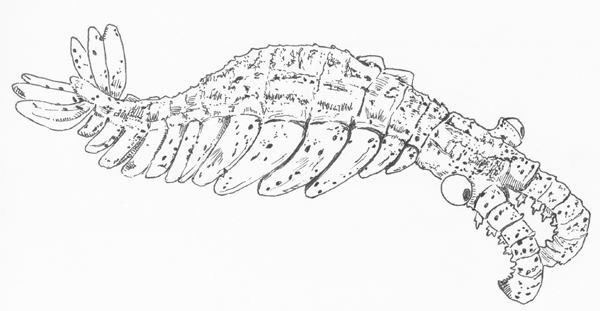World’s First Super Predator – Bigger and Longer Lasting than Previously Thought
Emerging out of the Burgess Shale deposits from British Columbia (Canada) is evidence of a remarkable marine community, indeed this famous geological deposit has yielded some of the most extraordinary fossils from the Cambrian Period found anywhere in the world. It is from strata such as this that evidence of the great diversity of Cambrian life has been gathered – the so called “Cambrian explosion”.
One of the most fascinating creatures around during this time was Anomalocaris “odd shrimp”, a nektonic (free-swimming) arthropod, around ten times bigger than any other animal known from that time and it is heralded as the world’s first super predator. This animal grew to in excess of sixty centimetres long, it had two large eyes situated on stalks on the side of its cephalon (head area) and two, large, spiky appendages that were held out in front of the animal and were probably used to grab prey items. Underneath the head, there was a circular mouth lined with sharp teeth. Anomalocaris was a segmented animal with flaps on each of its body segments that it undulated up and down in a wave-like motion to propel it through the water. Scientists had thought that like many animals from the Burgess Shale, Anomalocaris was an evolutionary dead end and that these creatures become extinct sometime in the Cambrian Period around 510 million years ago.
A Drawing of Anomalocaris
Picture credit: Everything Dinosaur
However, previous scientific thinking has once again been turned on its head with the discovery of fossil evidence indicating that Cambrian fauna, including Anomalocarids, and giant ones at that, were alive and well and living into the Ordovician.
Palaeontologists have discovered that a group of these remarkable ancient sea creatures existed for much longer and grew to much larger sizes than previously thought, thanks to extraordinarily well-preserved fossils discovered recently in Morocco.
Anomalocaris
Peter Van Roy (now at Ghent University in Belgium) and Derek Briggs, director of the Yale Peabody Museum of Natural History, have discovered a giant fossilised Anomalocarid that measures one metre in length. The Anomalocaridid fossils, preserved in silicate based concretions reveal a series of blade-like filaments in each segment across the animal’s back, which scientists think might have functioned as gills.
In addition, the creature dates back to the Ordovician period, a time of intense bio-diversification that followed the Cambrian, meaning these animals existed for 30 million years longer than previously realised.
Professor Briggs commented:
“The Anomalocaridids are one of the most iconic groups of Cambrian animals. These giant invertebrate predators and scavengers have come to symbolise the unfamiliar morphologies displayed by organisms that branched off from early lineages leading to modern marine animals, and then went extinct. Now we know that they died out much more recently than we thought.”
The specimens are just part of a new trove of fossils from Morocco that includes thousands of examples of soft-bodied marine fauna dating back to the early Ordovician period, 488 to 472 million years ago. Because hard shells fossilise and are preserved more readily than soft tissue, scientists had an incomplete and biased view of the marine life that existed during the Ordovician period before the recent discoveries in Morocco. The animals found in Morocco inhabited a muddy sea floor in fairly deep water, and were trapped by sediment clouds that buried them and preserved their soft bodies.
Peter Van Roy added:
“The new discoveries in Morocco indicate that animals characteristic of the Cambrian, such as the Anomalocaridids continued to have a considerable impact on the biodiversity and ecology of marine communities many millions of years later.”
The paper on this remarkable discovery appears in the scientific journal – Nature.
To view models of ancient prehistoric creatures including Anomalocaris: CollectA Age of Dinosaurs Prehistoric Life Models.







Leave A Comment